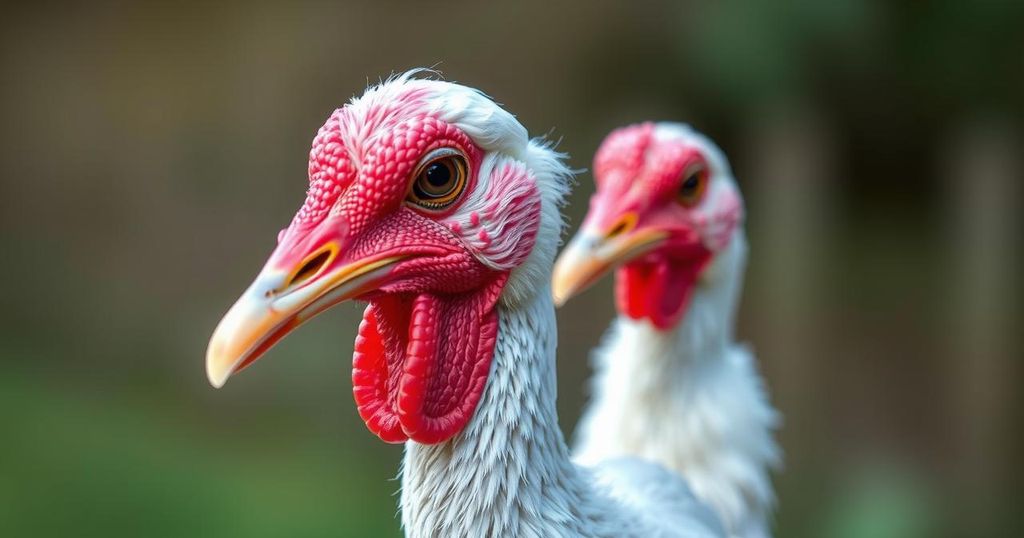Concerns Rise as Avian Flu Virus Crosses Species Borders, Affecting Animals and Humans

The H5N1 avian influenza virus has recently breached species barriers, causing deaths in tigers, leopards, and house cats, as well as severe illness in a Canadian girl. Experts express concern over its jumping ability and mutations that may increase virulence, emphasizing the need for enhanced monitoring and preparedness against potential outbreaks.
The H5N1 avian influenza virus has recently shown alarming trends, having resulted in the deaths of multiple animal species, including tigers, leopards, and house cats, as well as leading to a severe case in a teenage girl in Canada. In just one month, three tigers and one leopard succumbed to the virus in India, while eleven house cats died in California, raising concerns about the virus’s increasing ability to leap between species. Reports of human infections, though still limited, underscore a potential risk that warrants closer monitoring.
The H5N1 virus, primarily associated with avian populations, has recently spread to dairy farms across the United States, further heightening fears regarding its adaptability. The healthcare community has expressed particular concern about the ongoing trend of the virus infecting various species, as stated by Anurag Agrawal, Dean of BioSciences at Ashoka University, who remarked on the importance of vigilance in surveillance measures. Despite Agrawal’s reassurance that current human-to-human transmission remains negligible, he emphasized that the zoonotic transmission flavored with mutation poses an essential ongoing risk.
In India, severe symptoms were observed in big cats at a wildlife facility prior to their deaths, with the presence of the virus confirmed shortly thereafter. Simultaneously, in California, sudden deaths of house cats were linked to infected products, while outbreaks reported across dairy farms have reached 915 affected herds nationwide. Concurrently, a 13-year-old girl in British Columbia exhibited severe manifestations after contracting the virus, further suggesting a shift in H5N1’s infectious nature.
Experts highlighted significant gaps in surveillance, particularly in assessing genetic mutations of the H5N1 virus that may enhance its virulence. This was poignantly noted in the New England Journal of Medicine, which calls for more robust monitoring strategies and detailed recording of genetic information related to the viruses emerging in animal populations. The need for both comprehensive tracking mechanisms and heightened public awareness has never been clearer, especially as the virus’s journey has led it from Europe to North America and South America, indicating broadening host range adaptations.
As the global community responds to these developments, health officials stress the importance of active surveillance and have implemented necessary safety measures to mitigate risks. According to Dr. Pragya Yadav from the National Institute of Virology in Pune, India, “It may be worrisome but all measures and surveillance is in place.” The situation remains under close observation, and while there is no immediate need for public panic, heightened awareness and preparedness are crucial.
The H5N1 avian influenza virus, known for its predominant presence in birds, has made headlines due to its expanding host range, escalating concerns over its potential spread to mammals and humans. Following a series of recent fatalities among large cats and pets, alongside a serious human infection in Canada, there is a heightened urgency in understanding the virus’s transmission patterns. Experts believe the virus’s capability to breach species barriers signals an evolving threat, calling for robust epidemiological monitoring and preventive measures. As infections have been observed across multiple regions, rising concerns about food sources, such as dairy farms contaminated with the virus, also emerge.
In summary, the emergence of the H5N1 virus across various species presents a growing concern for public health officials and the scientific community alike. With recent fatalities among tigers, leopards, house cats, and a severe case in a Canadian girl, the need for vigilant surveillance and tracking has become paramount. Though human-to-human transmission remains low for now, the documented animal infections underscore the necessity for enhanced monitoring strategies and a proactive approach to prevent potential outbreaks. As experts continue to study the implications of genetic mutations in the virus, maintaining public awareness and readiness remains crucial.
Original Source: www.hindustantimes.com






